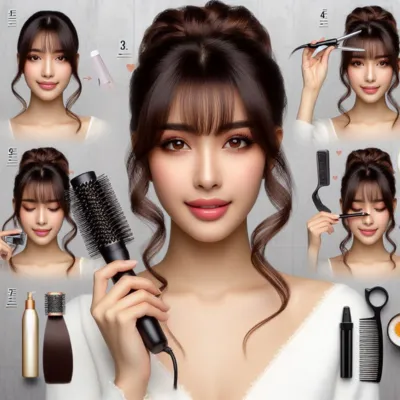Knotless braids are a special way to braid your hair without tight knots at the base. Unlike regular braids, they start smoothly with your natural hair and gradually add extensions as you braid. This makes them look more natural, feel lighter, and cause less pulling on your scalp.
You should choose knotless braids because they are gentler on your scalp and don’t cause discomfort like tight knots. They look more natural and blend better with your own hair, plus they’re easier to style and maintain, making them a convenient choice for any occasion.
Knotless braids offer tips on preparing your hair, choosing the right braiding hair, and trying out different hairstyles. By reading this article, you can learn how to maintain and enjoy the benefits of knotless braids confidently.
Preparing Your Hair
Preparing your hair is an essential step before getting knotless braids.
- Washing: Start by washing your hair with a gentle shampoo to remove any dirt, oil, or product buildup. Focus on massaging the scalp to ensure it’s thoroughly cleansed. Rinse out the shampoo completely.
- Conditioning: Apply a moisturizing conditioner to your hair, focusing on the lengths and ends. Use a wide-tooth comb to distribute the conditioner evenly and detangle any knots. Leave the conditioner on for a few minutes before rinsing it out thoroughly with lukewarm water.
- Detangling: Once you’ve rinsed out the conditioner, gently detangle your hair using a wide-tooth comb or a detangling brush. Start from the ends and work your way up to the roots, using short, gentle strokes to avoid causing breakage or pulling on the hair.
- Moisturizing: Apply a leave-in conditioner or hair oil to moisturize and nourish your hair. Pay special attention to the ends, as they tend to be drier and more prone to breakage. You can also use a moisturizing hair mist to keep your hair hydrated throughout the braiding process.
- Stretching (optional): If you have tightly coiled or kinky hair, you may want to stretch your hair before braiding to make the process easier and reduce tension on the scalp. This can be done using techniques such as blow-drying with a comb attachment or braiding your hair into large sections overnight.
Choosing Your Braiding Hair
Choosing the right braiding hair is crucial for achieving the desired look and ensuring the longevity of your knotless braids.
Synthetic vs. Human Hair
Decide whether you want to use synthetic or human hair for your knotless braids. Synthetic hair is usually more affordable and comes in a wide range of colors and textures. However, human hair blends more seamlessly with your natural hair and tends to have a more natural look and feel.
Color Matching
Choose a braiding hair color that closely matches your natural hair color for a seamless blend. If you’re looking to add highlights or create a contrasting look, you can opt for a different color or ombre effect.
Length and Thickness
Consider the length and thickness of the braiding hair based on the style you want to achieve and your natural hair texture. For longer braids, you’ll need longer extensions, while shorter braids may require shorter extensions. Additionally, thicker braiding hair will result in fuller and more voluminous braids, while thinner hair will create a sleeker look.
Texture
Select braiding hair with a texture that complements your natural hair texture for a cohesive look. Whether you have straight, wavy, or curly hair, there are braiding hair options available to match your hair texture.
Quality
Invest in high-quality braiding hair that is durable and tangle-free to ensure long-lasting knotless braids. Look for reputable brands known for their quality hair extensions to avoid issues such as shedding or tangling.
Braiding Technique
Mastering the braiding technique is key to achieving beautiful and long-lasting knotless braids.
Sectioning Your Hair
Divide your hair into small, even sections using a rat-tail comb. The size of each section will depend on the thickness of your natural hair and the desired thickness of your braids. Secure the rest of your hair out of the way using hair clips or elastic bands.
Braiding Process
Start with a small section of your natural hair at the base and divide it into three equal parts. Begin braiding your hair as you normally would, crossing the right section over the middle section, then the left section over the middle section.
Adding Extension Hair
Instead of incorporating extension hair right away, continue braiding your natural hair for a few stitches to create a sturdy base. Once you’ve braided a few stitches, begin adding extension hair by placing it under the middle section of your braid and incorporating it into the braid as you continue braiding.
Gradual Incorporation
As you braid, continue adding small amounts of extension hair to each section before crossing it over the middle section. This gradual incorporation technique helps to create a seamless and natural transition from your natural hair to the extension hair.
Tension Control
Pay attention to the tension as you braid to avoid pulling too tightly on your hair, which can cause discomfort and damage. Keep the tension consistent throughout the braiding process for uniform and neat-looking braids.
Removing Knotless Braids
Removing knotless braids properly is essential to prevent damage to your natural hair.
- Gather Your Tools: Before you begin, gather the necessary tools, including a pair of sharp scissors, a wide-tooth comb, hair clips or elastic bands, and a detangling spray or conditioner.
- Snip the Ends: Start by snipping the ends of each braid with sharp scissors to release the tension and make it easier to unravel the braids. Be careful not to cut your natural hair while doing this.
- Unravel the Braids: Working one braid at a time, gently unravel the braids starting from the ends and working your way up towards the base. Use your fingers to loosen any knots or tangles and avoid pulling on your hair.
- Detangle Hair: Once the braids are unraveled, use a wide-tooth comb to gently detangle your hair, starting from the ends and working your way up towards the roots. Apply a detangling spray or conditioner to help soften the hair and make it easier to comb through.
- Deep Condition: After removing all the braids, deep condition your hair to replenish moisture and nourish your strands. Apply a generous amount of conditioner or a hair mask to your hair, focusing on the ends and any areas that feel dry or damaged. Leave the conditioner on for at least 30 minutes before rinsing it out thoroughly with lukewarm water.
Conclusion
Learning to style knotless braids brings you endless styling options and comfort. This guide covered everything from preparing your hair, picking the right braiding hair, mastering the braiding technique, to safely removing the braids. By following these steps, you’ll achieve flawless knotless braids that look fantastic and keep your natural hair healthy.
Whether you prefer classic ponytails, elegant buns, or intricate braided styles, knotless braids offer versatility to express your style. Remember to prioritize hair health by protecting your edges, keeping your scalp moisturized, and taking breaks between styles. With practice and patience, knotless braids can be your go-to stylish and protective hairstyle.



I don’t think the title of your article matches the content lol. Just kidding, mainly because I had some doubts after reading the article.
Your article helped me a lot, is there any more related content? Thanks! https://accounts.binance.com/fr-AF/register?ref=JHQQKNKN
Модные заметки по выбору необычных образов на любой день.
Обзоры профессионалов, новости, все показы и шоу.
https://vladtoday.ru/news/2024-09-10-10-prichin-za-chto-my-lyubim-demnu-gvasaliyu/